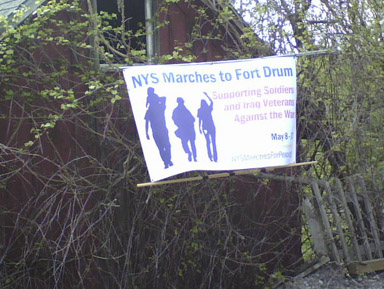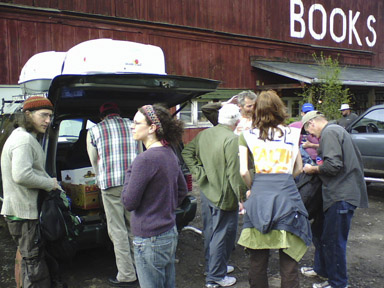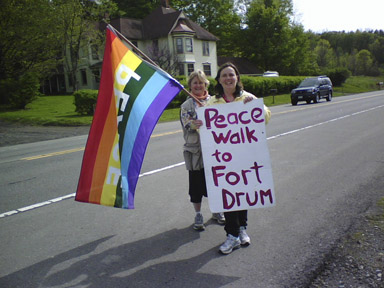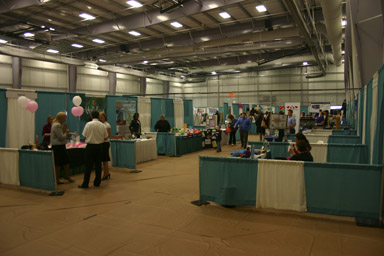May 2, 2008
Dryden school taxes barely climb
Now there's a fun headline. The Dryden schools' property tax levy will climb less than 1% this year. Spending increased 6.48%, but state aid increased 10%. This is a year to be nervous about state aid, however, as the prospects for the state's economy look dim.
There's now an $8,800 reward for the safe return of Bethanie Dougherty, $500 of which was raised at a candlelight vigil Wednesday night.
In yesterday's Journal, Dryden resident Mac Larsen was among those who filed to run for the Ithaca City School Board, one of six for four seats.
On today's opinion page, the Journal wisely shoots down the gas-tax holiday proposals, and some punk named Simon St.Laurent of Dryden writes to suggest that the values that get promoted for school boards may actually get in the way of them doing their job.
Playground build at Caroline elementary
On May 9th and 10th, there will be construction days at Caroline Elementary School playground. It's in Caroline, yes, but that school serves Dryden kids from Varna, Ellis Hollow, and Bethel Grove.
I had a good time at a similar building day at Dryden Elementary. This is definitely a great way to help kids, meet people, and even have fun.
Ellis Hollow Nursery School Open House Saturday
It's southwest Dryden education morning here, but there's also an event Saturday:
ELLIS HOLLOW NURSERY SCHOOL OPEN HOUSE
May 3, 9-11am
At the Ellis Hollow Community CenterWhat's it like to be a 3- or 4-year old child at the Ellis Hollow Nursery School? Find out!
Meet our nurturing and creative teachers, Ellie Biddle and Regi Carpenter
Pot a plant for Mother's Day
Do 10 things with dots (and a lot more)
Listen as Ms Regi weaves a story at 10am
Thinking ahead to the 2008-09 school year? We'd love to tell you more about our community school.
At our non-profit, parent cooperative nursery school, children learn as they do best -- with hands-on activities for observing, exploring, and experimenting.
Classes are held Tuesday, Wednesday, and Thursday, 9am-12noon, from mid-September through mid-June. Find out more online at http://www.ellishollownurseryschool.org/ or contact us at ellishollowns@gmail.com or 227-8006.
May 5, 2008
Poverty, water-tasting, clean-up
Saturday's Ithaca Journal was quiet on Dryden, but their continuing series on poverty is well-worth reading.
Energy East, the parent company of NYSEG, saw its earnings fall.
In today's paper, Bolton Point water, which serves western Dryden, won the annual taste test of local waters. (The article also mentions a Town of Dryden treatment plant - I'm pretty sure they mean Village of Dryden.)
Just to the east, it looks like a teaching winery will be coming to Cornell Orchards soon.
In Darts & Laurels, the Finger Lakes Land Trust thanks volunteers who helped in a clean-up on Irish Settlement Road.
Varna to get $20K for generator
Update: Wow, the overall state data is a snarl. The Journal's Saturday article used old data, making the discussion below into an incredible tangle. Start with the latest article on it, then jump down to Varna.
Saturday's Journal also noted that state legislators were handing out $147 million for community projects, in member-item spending. It's a grotesque system, and the article notes for example that Senate Republicans, who have a 32-30 majority, have $88 million to hand out, while Senate Democrats get $992,000.
Update: There's more on the Assembly spending at The Albany Project. The Assembly Democrats, who have a 106-42 majority, spent $57.3 million on their projects while Republicans spent $4.9 million.It's a mere 11-1 ratio instead of an 88-1 ratio, but only looks better because the Senate numbers are so grossly disproportionate. Update: It looks like the Journal article's numbers were wrong, or maybe for 2007. This piece on the Senate spending suggests that the Senate Republicans have $76.096 million to hand out, and Senate Democrats have $8.983 million. That's more like 8-1 than 88-1, though still pretty awful.
Some of that money, of course, is coming to this area. I haven't managed to sort out Senator Seward's spending yet, but deep inside the barely-organized PDF file of Assembly items (they couldn't make it easy to see the spending, you know!) is this item:
SFY 2008-2009 LEGISLATIVE INITIATIVE FORM
Legal Name, Address, and Telephone Number:
VARNA COMMUNITY ASSOCIATION, INC.
943 DRYDEN ROAD - P.O. BOX 4771
ITHACA, NY 14852
(607) 272-2658
Name of Project Director:
DAWN POTTER
Purpose of Project:
FUNDS WILL BE USED FOR THE PURCHASE OF A 40KW MULTI-FUEL GENERATOR. WORKING WITH TOMPKINS COUNTY RED CROSS, VARNA COMMUNITY CENTER HAS BECOME AN EMERGENCY SHELTER.
Funded Amount:
$20,000
Requested By:
LIFTON
Name of Administering State Agency:
DEPARTMENT OF HEALTH
The Varna Community Center also now has a walk-in refrigerator and freezer to support the emergency shelter project, which has had mixed levels of support from the town in past administrations. I hadn't heard that much about this piece of it lately until I stumbled on it in that file.
I've put the rest of the items that were solely sponsored by Assemblywoman Lifton in the extended entry, and I'll do the same for Senator Seward when my patience returns. Search... cut... paste... argh. Feeling impatient? Here's the Senate list of 5,191 items, on 5,191 pages.
SFY 2008-2009 LEGISLATIVE INITIATIVE FORM
Legal Name, Address, and Telephone Number:
ZAP (ZERO ADOLESCENT PREGNANCY) PROGRAM
60 CENTRAL AVENUE
CORTLAND, NY 13045
(607) 758-5586
Name of Project Director:
ELAINE LAMBERT
Purpose of Project:
FUNDS WILL BE USED TO TRAIN PEER EDUCATORS AND PROVIDE INFORMATION AND SUPPORT, HELPING TEENS TO MAKE HEALTHY CHOICES AND POSITIVE BEHAVIOR.
Funded Amount:
$10,000
Requested By:
LIFTON
Name of Administering State Agency:
DEPARTMENT OF HEALTHSFY 2008-2009 LEGISLATIVE INITIATIVE FORM
Legal Name, Address, and Telephone Number:
CORTLAND DOWNTOWN PARTNERSHIP, INC.
P.O. BOX 224
CORTLAND, NY 13045
(607) 342-6460
Name of Project Director:
LLOYD PURDY
Purpose of Project:
FUNDS WILL BE USED TO REPLACE AGING PHYSICAL STREET SCAPE; PROMOTE BUSINESS DEVELOPMENT; ERECT BUSINESS DIRECTORY MAPS; INSTALL LED LIGHTING AND HISTORIC ENVIRONMENT ELEMENTS.
Funded Amount:
$12,000
Requested By:
LIFTON
Name of Administering State Agency:
DEPARTMENT OF STATESFY 2008-2009 LEGISLATIVE INITIATIVE FORM
Legal Name, Address, and Telephone Number:
ENFIELD VOLUNTEER FIRE COMPANY, INC.
172 ENFIELD MAIN ROAD
ITHACA, NY 14850
(607) 273-8256
Name of Project Director:
SEAN OWENS
Purpose of Project:
FUNDS WILL BE USED TO REPLACE MALFUNCTIONING THERMAL IMAGING CAMERA.
Funded Amount:
$10,000
Requested By:
LIFTON
Name of Administering State Agency:
DEPARTMENT OF STATESFY 2008-2009 LEGISLATIVE INITIATIVE FORM
Legal Name, Address, and Telephone Number:
ITHACA BREAST CANCER ALLIANCE
612 WEST SENECA STREET
ITHACA, NY 14850
(607) 277-0960
Name of Project Director:
SHAWN GALBREATH
Purpose of Project:
FUNDS WILL BE USED TO REPLACE 50 YEAR OLD WINDOWS WITH ENERGY EFFICIENT-UPGRADED, ENVIRONMENTALLY FRIENDLY WINDOWS.
Funded Amount:
$26,000
Requested By:
LIFTON
Name of Administering State Agency:
DEPARTMENT OF STATESFY 2008-2009 LEGISLATIVE INITIATIVE FORM
Legal Name, Address, and Telephone Number:
SPEEDSVILLE COMMUNITY ASSOCIATION
262 DIAMOND ROAD
BERKSHIRE, NY 13736
(607) 657-8379
Name of Project Director:
DON BARBER
Purpose of Project:
FUNDS WILL BE USED FOR UPGRADES TO THE COMMUNITY HALL, INCLUDING FOUNDATION REPAIR AND PLUMBING UPGRADES.
Funded Amount:
$3,000
Requested By:
LIFTON
Name of Administering State Agency:
DEPARTMENT OF STATESFY 2008-2009 LEGISLATIVE INITIATIVE FORM
Legal Name, Address, and Telephone Number:
EAST END COMMUNITY CENTER
46 ELM STREET
CORTLAND, NY 13045
(607) 428-0497
Name of Project Director:
JAMES C. NICHOLS
Purpose of Project:
FUNDS WILL BE USED TO CONTINUE THE “SOUTH END COMMUNITY POLICING DETAIL.”
Funded Amount:
$25,000
Requested By:
LIFTON
Name of Administering State Agency:
DIVISION OF CRIMINAL JUSTICE SERVICESSFY 2008-2009 LEGISLATIVE INITIATIVE FORM
Legal Name, Address, and Telephone Number:
TOMPKINS COUNTY PUBLIC LIBRARY
101 EAST GREEN STREET
ITHACA, NY 14850
(607) 272-4557
Name of Project Director:
JANET STEINAR
Purpose of Project:
FUNDS WILL BE USED TO PROVIDE SUNDAY STAFFING FOR LIBRARY HOURS.
Funded Amount:
$18,000
Requested By:
LIFTON
Name of Administering State Agency:
EDUCATION DEPARTMENTSFY 2008-2009 LEGISLATIVE INITIATIVE FORM
Legal Name, Address, and Telephone Number:
TOMPKINS COUNTY OFFICE FOR THE AGING
320 N. TIOGA STREET
ITHACA, NY 14850
(607) 274-5482
Name of Project Director:
LISA HOLMES
Purpose of Project:
FUNDS WILL BE USED TO PROVIDE MEDICAL ALERT (PERSONAL EMERGENCY RESPONSE) MACHINES TO FRAIL, ELDERLY AND DISABLED RESIDENTS OF TOMPKINS COUNTY.
Funded Amount:
$10,000
Requested By:
LIFTON
Name of Administering State Agency:
OFFICE FOR THE AGINGSFY 2008-2009 LEGISLATIVE INITIATIVE FORM
Legal Name, Address, and Telephone Number:
FINGER LAKES INDEPENDENCE CENTER, INC.
215 FIFTH STREET
ITHACA, NY 14850
(607) 272-2433
Name of Project Director:
LENORE SCHWAGER
Purpose of Project:
FUNDS WILL BE USED TO REPLACE THE OUTDATED COMPUTERS WHICH LIMIT THE SCOPE AND CAPACITY OF PROGRAMS OFFERED BY THE FINGER LAKES INDEPENDENCE CENTER.
Funded Amount:
$6,000
Requested By:
LIFTON
Name of Administering State Agency:
OFFICE OF CHILDREN AND FAMILY SERVICESSFY 2008-2009 LEGISLATIVE INITIATIVE FORM
Legal Name, Address, and Telephone Number:
VILLAGE AT ITHACA
P.O. BOX 6776
ITHACA, NY 14851
(607) 256-0780
Name of Project Director:
CAL WALKER
Purpose of Project:
FUNDS WILL BE USED FOR THE IMPLEMENTATION OF A NETWORK AND REFERRAL DATABASE THAT WILL CONNECT UNDERSERVED YOUTH TO PROGRAMS, SUPPORTS AND SERVICES.
Funded Amount:
$20,000
Requested By:
LIFTON
Name of Administering State Agency:
OFFICE OF CHILDREN AND FAMILY SERVICESSFY 2008-2009 LEGISLATIVE INITIATIVE FORM
Legal Name, Address, and Telephone Number:
HISTORIC ITHACA, INC. - THE CLINTON HOUSE
116 CAYUGA STREET, N.
ITHACA, NY 14850
(607) 273-5796
Name of Project Director:
VICTORIA ROMANOFF
Purpose of Project:
FUNDS WILL BE USED FOR THE RESTORATION OF THE CLINTON HOUSE, INCLUDING ROOF REPAIR, REPAIR OF FALLING STUCCO, MORTAR JOINTS, ATTIC INSULATION AND CARPENTRY REPAIR TO ARCHITECTURAL DETAIL.
Funded Amount:
$20,000
Requested By:
LIFTON
Name of Administering State Agency:
OFFICE OF PARKS, RECREATION AND HISTORIC PRESERVATIONSFY 2008-2009 LEGISLATIVE INITIATIVE FORM
Legal Name, Address, and Telephone Number:
CORTLAND COLLEGE CHILDREN CENTER
TWIN TOWERS, ROOM 131
CORTLAND, NY 13045
(607) 753-5955
Name of Project Director:
JOHANNA HARTNETT
Purpose of Project:
FUNDS WILL BE USED FOR COSTS ASSOCIATED WITH MOVING THE CHILD CARE CENTER, ENABLING MULTIPURPOSE ROOM ACCESSIBILITY FOR PARENTS, TEACHERS, SUNY STUDENTS INTERESTED IN PROVIDING CHILD CARE LEARNING TOOLS, LENDING LIBRARY, STAFF DEVELOPMENT, ETC.
Funded Amount:
$20,000
Requested By:
LIFTON
Name of Administering State Agency:
STATE UNIVERSITY OF NEW YORK
May 8, 2008
Recreation meeting tonight
It's been a busy few days.
If you have the chance, please go to the Recreation master plan discussion tonight. Recreation's been a key topic in Dryden for years, and an area that the Town has pushed hard to improve in a lot of directions. If you'd like a chance to suggest more directions - activities, trails, parks, facilities, and more - tonight's the best time to get into the conversation.
Cathy Wakeman's Dryden Town Talk offers a roster of events for Mother's Day weekend and beyond.
It sounds like drinking led to a collision at 13 and Lower Creek Wednesday.
The county legislature is aiming at a 3% tax levy increase this year.
There's also more rabies in the county this year. Be careful!
There's an article on the new I Love NY campaign, which I have to agree is about the worst thing to happen to upstate NY since... oh, wait. They're canning the upstate development guy. That's probably worse than squirrels, butterflies, and grass growing. Or maybe we just need the grass to grow over the Empire State Development Corporation?
Gadabout needs more volunteer drivers.
I'll cover the opinion pages in a separate article.
May 9, 2008
Yesterday in photos
I'm way behind on everything, but hopefully these photos will give you some idea of the past few days. Well, all of them are from yesterday, except for the obligatory (and fun) Sungiva photo.
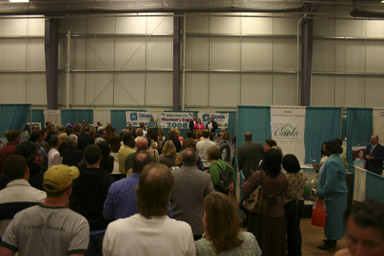
Recognizing the 20 Outstanding Women You Should Know at the Women's Expo at TC3.

Relaxing at the Women's Expo at TC3.
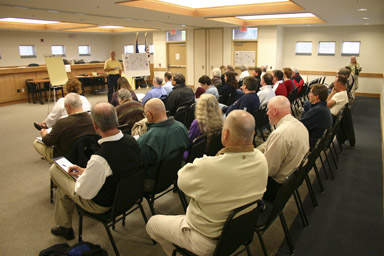
Recreation master plan meeting.
And then my camera's battery died.
May 12, 2008
Caroline playground build
Wow am I behind here. I still need to catch up to last week's opinion pages...
In this morning's Ithaca Journal, there's a report on Saturday's volunteer day building the playground at Caroline Elementary School, where most young Dryden students in the Ithaca schools go.
In state news, the garbage truck trainwreck is over - Governor Paterson ordered the DOT to start designating routes for trucks carrying garbage. It seems not to have been that difficult.
And the Journal's site seems to have a whole new look, including what seems on the surface like a new forum system.
May 13, 2008
Meet the Dryden School Board candidates
I'd missed this one, but Dryden Daily KAZ points out that there's a school board candidates forum tomorrow at 7:00pm in room C13 of the Dryden Middle School/High School.
Budgets, assessments, garbage trucks, decisions
This morning's Ithaca Journal is quiet on Dryden but has lots of regional and county news.
In county budget news, the County took a step away from administering the WIC program directly with a committee vote. (The headline is misleading, and it would be nice if the article listed who voted for and against.) There's also a piece on community involvement in the budget.
The Journal's editorial looks at another budget-related question, the assessments on which property taxes are levied.
In political news, the Journal notes Governor Paterson's decision to have the DOT regulate garbage truck traffic, which should be good news for residents on Route 79. I see elsewhere that Assemblywoman Barbara Lifton applauds the move, even though she spent a lot of time earlier arguing that it was unconstitutional. Perhaps she changed her mind after getting run over on this issue by fellow Democrats Schumer and Paterson.
Also in political news, the Journal notes that Tompkins County has a Democratic superdelegate, Tompkins County Democratic Chairwoman Irene Stein, who has a large decision to make soon, between Clinton and Obama. (She's a Democratic National Committee member, appointed to that seat by the New York State Democratic Committee.)
Ethics guidelines
I never got to last week's opinion pages, where there was a lot of Dryden opinion.
One piece that's kept me thinking is Mike Lane's letter on the need for a county code of ethics. I've spent a lot of time worrying about influence at the town level, where it's tended to be informal, and at the state level, where our dysfunctional legislature has insititutionalized influence. I haven't really thought about the county level, which is big enough to be where things shift from informal to institutional.
Lane is right that elected officials need to make a point of avoiding employment that raises questions about their ties to other branches of government. It does limit opportunities for them, but at bottom we really need officials whose constituency is their voters, not their employers. (And I can say the same for state legislators with their bogus part-time for $79,800 approach.)
Murray Cohen of Dryden objected to the few charitable donations on Governor Paterson's tax forms.
Mike Ciborowski of Freeville wrote to object to newspaper dumping on Tehan Road this winter.
The Journal's Tuesday editorial looked at ways to improve education's ability to address poverty.
The Journal's editorial approved of the legislature's 3% tax levy goal.
May 15, 2008
Dryden Dems to discuss local response to energy prices May 21
Dryden Democrats will be discussing "Local Responses to Rising Energy Costs." We've all seen energy prices climb and keep climbing, and that has a direct effect on Dryden residents' wallets. What can we do at the local level to reduce that impact?
Dryden residents with insights to share or interest in the issue are strongly encouraged to attend. The meeting will be at the geothermically-heated new Dryden Town Hall, 93 East Main Street, at 7:30pm on Wednesday, May 21st.
(We're holding meetings focused on specific issues every other month - there's more to politics than planning for specific races!)
May 17, 2008
Getting to Nodal Development in Dryden
[Update: I no longer think this is a good idea. See the category listing for more information on why. This piece in particular is a concise summary.]
[This is long - it's a complex subject and a couple of years of thought on it.]
Nodal development is a popular phrase with planners, as it promises more efficient use of resources, a less-stressful pedestrian way of life, more community, and even lower taxes.
Unfortunately, that warm fuzzy glow tends to vanish as soon as people start looking at what's involved in creating nodal development. The maps especially tend to make people gasp, wondering "You're going to do that in my neighborhood?" or "I want to live out here - who are you to say I can't?"
Overall, nodal development has many benefits, including:
Much greater pedestrian-friendliness, as distances are small enough to walk.
Where distances are too long to walk, it's still easy enough to build mass transit, even mass transit that breaks even or turns a profit.
People living close together can make much better - and cheaper - use of expensive infrastructure like water and sewer systems.
Fewer roads mean less paving means less cost.
Schools can be in neighborhoods, reducing the amount of busing needed.
Smaller stores have a chance to be an integral part of walking neighborhoods.
Less need to drive means less gasoline consumed.
And much more...
Is there a way to get to these benefits without the uproar?
Probably, though I don't think the path I suggest here will make either planners or libertarians happy.
First: Let Fresh Experiments Happen
For some percentage of the population, life in a dense node already makes a lot more sense than life on a half-acre lot. Senior citizens often downsize and move into smaller places once their children grow up and they retire. Ecovillage enthusiasts and similar groups sometimes want to build denser and more efficient housing. Some parents with children seek walkable neighborhoods where they don't have to drive their kids everywhere.
Building places that suit these groups can be difficult, however, in places where zoning or subdivision requires minimum lot sizes, setbacks, or other limitations that make it hard to put buildings close to each other.
These rules often are there for a reason, of course. Septic systems require a lot of space and the right soil type, and municipalities are smart to insist that houses on septic systems have enough room for a second septic system after a failure. On a different level, but just as important, existing neighborhoods see these rules as a protective wall against sudden changes to their community's character.
The rules, though, can be an unnecessary barrier in situations where, for example, multiple houses in new development could share a common sewer (or water) system. It doesn't have to be a full-scale municipal sewer system, though it should have some structure, but there are certainly ways to create neighborhoods even in far-flung corners without spacing houses one hundred yards apart.
Setback requirements can cause similar problems. While it is frequently possible to get variances on setbacks, they can make it especially difficult for denser neighborhoods to emerge. They also often lead to long expanses of commercial areas whose parking lots dominate the view, putting them far from possible pedestrians and making them feel unwelcome.
I'm not suggesting that planners get out of the business of planning, but it does seem reasonable to examine existing planning and zoning for issues that make it difficult for nodes to emerge and consider changing them. If someone wanted to build an EcoVillage along Route 13 in Dryden, or turn the NYSEG building into apartments, for instance, why should the Town stop that?
Establishing rules for conservation (or cluster) subdivisions is one option. In these, much of a land area is left untouched while denser housing goes into a smaller space. Changing setback rules for particular districts where nodes are close to existing anyway might be another possibility. It might also make sense to examine where lots of variances have been granted - or neighborhoods built earlier don't match the rules - and consider adjusting rules in those areas to reflect the reality of those neighborhoods.
Second: Remember the Past
Nodal development peaked long before planning and zoning became common. Before the 20th century, people lived in cities, villages, hamlets, and farmhouses. They usually lived there because they were doing something there - working, farming, trading. It made sense for people to congregate around intersections, in cities, near workplaces. It also made sense for people to be dispersed in the countryside growing food. There wasn't however, the constant daily traffic between these places, because that would have taken a lot of energy and effort. The city didn't start growing into the countryside until transportation costs fell, first thanks to the railroads and then to the car.
In areas that haven't been entirely swamped by sprawl (or by city growth), these old patterns are often still evident, though sometimes changed by later development. Old villages often remain commercial centers; hamlets develop into suburbia; farmland may still be productive, gone to forest, or swallowed up by earlier growth. Cities may lose their way entirely and decay, but they rarely vanish.
These older patterns and their modern remnants generally reflect a pattern that can be woven into the current desire for nodes, though it won't necessarily fulfill the ambitions of planners who want high-density development. Even if these older nodes have disappeared, the reasons for their earlier existence - transportation, water, industry - may still exist. Those advantages may be dormant in the face of lowered energy costs that have let people live across the landscape, but they can return if the situation changes.
(It's also good to look around at large-scale change to those historic patterns. Massive infrastructure, like blasting large roads through difficult areas, or aqueducts, or the addition of water and sewer pipes to an area can change the old equations.)
Preserving places with a long sense of their own history offers a story that may be more compelling than building new places which fit a theme popular among planners.
In Dryden, the key past nodes were the Villages of Dryden and Freeville, along with the well-defined hamlets of Varna, Etna, McLean. Bethel Grove and Ellis Hollow were more neighborhoods than hamlets, but certainly existed. West Dryden (with its church) and Malloryville (with its water-powered industry) were also important places on the Dryden landscape. Schoolhouses created a sense of community in smaller areas all over the town.
The re-routing of Route 13 on the western side created a new industrial and commercial node where it overlaps with Route 366, and as-yet unrealized potential for more development at Hanshaw and Lower Creek Road.
Third: Improve What You Have
The old nodes were built for 19th-century traffic patterns, narrow roads lightly traveled. Houses and businesses were often built close to the road, and parking wasn't an issue. Intersections were important because they connected different places, not because they created a pause in the flow of fast-moving traffic.
The 19th-century nodes suffered in the 20th century, as the automobile changed both infrastructure and expectations of what a place should be. Traffic that stops in a place is still a benefit, just as it was before, but traffic that just passes through imposes costs on communities that no one actually pays for.
The Villages of Dryden and Freeville have perhaps done the best, but both have large traffic flows cutting right through their heart. Dryden's "four corners" in particular is a difficult place to cross the street, and parallel parking on West Main Street (Route 13) is a challenging experience. There's plenty of parking in the area, but it's not obvious from 13 that this is a pedestrian-friendly area. Freeville is better in this respect, though 38 creates some similar difficulties.
Among the hamlets, Etna is cut in half by Route 366, and McLean has steady traffic along Fall Creek Road and Peruville Road. Varna is probably the hardest-hit by traffic of the old hamlets, as most of it was built right along what was a narrow and quiet - though important - road. Varna's proximity to Cornell has made it attractive for renters and landlords, reducing the investment made in buildings already challenged by the nearness of the road and further accelerating its physical decay. While Varna has done well with auto repair, the grocery, pharmacy, and other neighborhood businesses have disappeared as larger stores appeared at East Hill Plaza.
Traffic will also be a challenge for the possible new nodes. The existing businesses on the 13/366 overlap are there largely because of the traffic, true - but 17,000 vehicles passing daily makes it hard to imagine coherent development on both sides of the highway.
How can communities address this, to make sure these densest areas of the Town are popular? Freeville and Dryden already have the largest advantage, because they are incorporated as villages and therefore have much more control over their own destiny than the hamlets, which rely on the Town for government, including planning.
The ingredients for making nodes attractive are already there, in some cases, though they can pretty much always use improvement. All of them cost money, of course.
Dryden and Freeville have the sidewalks necessary to give pedestrians a comfortable area to walk. Varna has been asking for them for a long time, however, and it's not clear if Etna or McLean want them.
Trails are another amenity that can make living in these places more fun. Dryden has the Jim Schug trail, though in its current configuration it's mostly good for recreational use. When it connects to Freeville and then Freeville connects to Varna and Ithaca, then the trail might have some use in giving people a pedestrian- and bicycle-friendly connection between nodes.
One feature that most of the old nodes and some of the neighborhoods have is community centers. Varna, Etna, Ellis Hollow, and Bethel Grove have long had community centers, and a new Community Center Cafe recently sprouted in the Village of Dryden. Freeville's church, school, and fire company provide centers of activity, and other churches, fire departments, and schools help bring people together. The Town is already supporting the community centers and fire departments, two key aspects of Town policy that already support nodes.
The importance of schools as centers of community helps explain the concerted resistance to closing down the Freeville and Cassavant [McLean] elementary schools, despite the cost of keeping them open. This might serve as an important reminder that the meaning of 'improvement' isn't just up to planners - it's up to the residents of the actual nodes as well. Forcing unwanted change on the places a plan supposedly supports is not a good way to write plans.
Fourth: Change the Conversation
A lot of nodal development conversation reminds residents who already live in nodes of that classically awful phrase, "We had to destroy this village to save it." Planning vocabulary isn't entirely comforting. Zoning vocabulary is by its very nature constraining. Perhaps worst of all, the use of even advisory plans as ammunition for criticizing other projects makes a lot of people deeply suspicious of any planning.
Yes, change is almost always uncomfortable, and discussing change is scary. Discussing proposed changes in where people live is especially terrifying, whether the listeners are those told they're in the wrong place or those told their neighborhood should be growing rapidly.
Still, there are better ways to hold the conversation. The basic idea behind all of this is simple:
Live close to where you work, and the places you usually go.
Planners at a variety of Dryden-related projects have talked about this, gotten general approval for the idea, and then come back with plans that implement it which don't always go over very well.
In part, that's because the planning toolkit often runs to maps and drawings, showing people suggested end results rather than letting the people figure out how that result might develop over time. There's little connection between the broad motivations behind the plans and the way that plays out over the typically 20-year timeframe that long-range planning explores.
It takes a lot longer to ask people about various scenarios and walk through what might happen in a neighborhood, but the sitting down and listening makes a big difference. For short-term projects, it might even make sense simply to ask what residents want, collecting things that would make their neighborhood stronger. Outlining paths to get there will likely require both planners and residents to accept some pieces that might not be their favorite approach if they could have everything the way they want it. Listening and compromising does make it easier to build agreement, over time.
In planning, everyone's an expert - or at least everyone thinks so. It's not hard for people to imagine what change in a place might look like, or what effects it might have on the surrounding area. If there's a field where the separation between "expert" and "non-expert" can cause problems, it's planning.
None of these conversations will be easy, and some of them will be unproductive or counterproductive. Given what's at stake in these conversations, however, they're necessary.
Fifth: Be Patient
This one is hard. Patience is nearly always hard - easy counsel to give, difficult counsel to accept.
Yes, the world has lots of problems, many of them caused by our love for the automobile. Even beyond climate change, energy prices are likely to keep climbing, and residents of sprawling neighborhoods are eventually going to suffer for their choices. Yes, we are going to end up with a good deal of wasted infrastructure, and yes, there's a lot of harm that could be avoided if only we could start making drastic changes today.
It's not that easy, though. Impatience generates its own resistance. The problem here isn't the automobile, sprawl, or greenhouse gases - it's people. People change more slowly than may seem good for them, and telling them to change doesn't necessarily mean that they're going to change faster. Even with a shared sense of mission, change is difficult.
Perhaps the place people want to change most slowly is their home. We've become accustomed to changing jobs and changing schools over the past few centuries, and there are even some people who migrate from home to home regularly. However, once people have made the effort to settle into a home on what they hope is a permanent basis, many forms of change are unwelcome.
It's not just about "lowering property values" or "not in my backyard" - it's about the quality of life people found when they arrived and the quality of life they expect o continue. If that quality of life changes, then resistance to a lot of these options (and even resistance to moving) may fade.
There are two ways to shift that quality of life in ways that encourage nodal development, and both pose problems for government
The first, more positive approach, is to improve the quality of life within the nodes. Adding features can make the nodes more attractive, whether sidewalks, trails, activities, or places where community can develop. Unfortunately, that often costs a substantial amount of money, and can leave taxpayers outside of the nodes resentful about why they're investing in a place they don't actually live.
The second, more negative approach, is to reduce the quality of life outside of the nodes. Most of the things that government could do to achieve this are pretty much guaranteed to be considered poison in the Town of Dryden. While it may be acceptable to create zoning that leaves certain areas lightly developed, zoning that would abolish sprawl by itself is not even remotely politically palatable.
As far as governmental options are concerned, democracy makes the first option appealing but limited, and pretty much bars the second option. Patience, in practice, may be the only choice here.
So is it hopeless? Will more and more sprawl devastate the environment ever more severely?
No. For better or worse, there are other factors at work. The most visible of them is the steady increase in energy prices, which is already making it much more expensive to live far away from work and school. Transportation costs have already doubled in the past few years, and there's little sign that gasoline in particular will be coming down any time soon.
For people already living far from population centers, this continuous drain on their pocketbooks is not very attractive. More efficient vehicles will ease the impact of this over time, but those also come with their own investment costs. Change will be slow, though. Current prices aren't likely to make a lot of homeowners move into denser housing elsewhere, and that flow will be slowed by the increasing likelihood of taking a loss on the house price.
Perhaps there's reason to hope, however, for people looking to find new homes. When people are still in the decision-making phase, and haven't yet made the investment of moving and settling in, it's a lot easier to examine all of these costs. While the appeal of lots of property and possible self-reliance will guarantee some people keep moving to the distant corners of the town, a lot of others are going to seek cheaper and more convenient paths - making nodal development a much more appealing prospect.
In many ways, the challenges here are about timing. Outside of a few activist communities, there isn't a tremendous call for government to clamp down on development outside of the nodes and to encourage development inside the nodes. At the same time, though, there hasn't been a building boom in the nodes, and even if people find the nodes attractive, they can't live in them if there isn't housing.
So what might the path forward look like?
Emphasizing the advantages of life in the villages and hamlets
Making the hamlets and villages as attractive to people seeking places to live as possible, while being cautious not to generate resentment from those outside of them.
Offering tools that allow new development outside of the existing nodes to take on as nodal a character as possible.
Listening to residents carefully to know what affect increasing energy prices are having on opinions about how they want to live.
Preparing to offer infrastructure that will support more efficient ways of life.
Working to develop community that can help these nodes flourish for both current communities and future residents.
Yes, that's a limited approach, one many activists doubtless will consider far too passive. Unfortunately, it rarely pays off for government to get too far ahead of what citizens actually want today. Presenting scenarios and telling people they should want something isn't going to make them want it, or make them accept the change needed to implement it.
These issues go to the heart of how we choose to live, work, raise our children, and interact with our neighbors. That makes questions about the nature of our neighborhoods likely the most contentious subject local government addresses. There is a path forward through that minefield, but it's a path that requires letting people learn for themselves why changing their ways is a good idea.
May 20, 2008
School votes today
School board and budget votes are today, with contested elections in both the Dryden and Ithaca school districts. Ithaca City School District voters vote in many places.. As usual, Town of Dryden residents living in the Ithaca City School District, have a complicated maze of places to go, mostly but not entirely different from their usual polling places:
If you live in election district 1 or 5 (meaning you vote at Etna Fire Station in regular elections), the parts of the Ithaca district east of Baker Hill Road, you vote at Northeast Elementary School (map).
If you live in election district 4, which includes Varna, Hanshaw Road from Ithaca to Route 13, and the area between Game Farm and Turkey Hill Roads, you vote at the Varna Community Center (map).
If you live in election district 8, the south side of Ellis Hollow Road over Snyder Hill to Route 79 and Bethel Grove (and normally vote at Bethel Grove Church), you vote at the Belle Sherman Annex (map).
If you live in election district 9, the north side of Ellis Hollow Road, Ellis Hollow Creek, Ringwood Road, and many other smaller roads there, then you vote at Caroline Elementary School (map) instead of your usual polling place in Varna.
ICSD polls are open from noon to 9:00pm.
The polling place for Dryden schools is the Middle School High School Auditorium, from 7:00am to 9:00pm.
May 22, 2008
Intermittent
You've probably noticed a fall-off in postings here lately, and may be able to guess at the reason. (Yes, I'll be posting more pictures, of course!)
When I started, a steady drumbeat of stories seemed like the best way to keep myself going here. Unfortunately, I'm not able to maintain that very well now, and when I fall behind, there's a lot of catching up to do. That makes it even harder to get started again, so...
I'm going to pause on the usual reporting of "what's in the Ithaca Journal today", along with the Cortland Standard and Dryden Courier. If there's anybody out there willing to pick that up, please let me know. It doesn't take that long, probably 15 minutes a day.
I just need to find those 15 minutes right now! I'll still be posting here occasionally, just not at the same steady rate I've been in the past.
(And the key stories I've missed so far are this on Karel "Ricky" Westerling's release after a guilty plea to lesser charges, Ithaca and Dryden school election results, Dryden Town Talk, and the declining likelihood that Melea Bartley's employees will ever get paid.)
May 24, 2008
Back pay problems
Letter writer Christine Griffin of Groton is clearly unhappy about Melea Bartley's year of jail ending the thousands of dollars in back wages she owes.
In Darts and Laurels, Jay Hulslander thanks the Dryden Veterans Memorial Home for honoring "the town of Dryden's deceased veterans by placing flags on each of their graves".
There's a piece on pensions and legislative pay that I wish provided a complete set of data on county legislative pay - not just what other counties pay, but how many legislators they have, and how much they work (or are supposed to work.)
May 26, 2008
Memorial Day parade today in Village of Dryden
Thanks to Mike Lane, who wrote:
Geoff Dunn reported on WHCU yesterday that the parade will be Monday at 10:30AM.
The parade lines up before that at Highland Drive and marches down to the Village Green where the service takes place at the monument.
After the parade everyone (families included) is invited up to the American Legion building for the traditional and complimentary luncheon.
There is parking in the municipal lot on George Street, and also in the Village lot on the south side of the Village Hall.
Update: The ceremony was at 10:30am, not the parade, so I missed the parade. I did, however, put up a gallery of pictures of the ceremony.
Memories
I said I'd take a break from covering the Journal, and then, of course, they started publishing lots of things that deserve highlighting.
For Memorial Day, they remember WWII veteran Bud Hulslander and his work remembering veterans. In the Life section, Crystal Howser of Freeville also remembers Hulslander, her grandfather.
In their piece on Cornell's graduation, they note a Dryden resident's graduation and exceptional works:
Skorton used Jessica Houle, a graduate from Freeville who grew up in Conger's mobile home park, as an example of a social entrepreneur. Houle created a program to provide mentoring and recreation and leadership opportunities in mobile home parks. Houle has been recognized for her work to bring equality to the social strata as the recipient of the Maribel Garcia Community Spirit Award.
"The tangible results of social entrepreneurship can be breathtaking and inspirational," Skorton said. Later in his speech he added, "Cornell and its alumni have taken their responsibility for public service very seriously for 150 years. We seek to apply knowledge and creativity for the public good and to lighten the burdens of the world."
In Darts and Laurels, Dryden resident Susi Varvayanis thanks participants in their second annual Public Engagement and Science Communication Symposium, including "students from Dryden High and Tompkins Cortland Community College, who brought perspective and insightful comments to the competitors". Deborah Parker sends thank yous for the "Mock Car Crash" at Dryden High School.
May 27, 2008
Will Route 366 get quieter?
I've been writing a fair amount about garbage-truck traffic lately, both here and elsewhere. That originally interested me because of the politics involved, but it has me looking at - and listening to - the road in front of my house more closely again. I don't have those garbage trucks, but I certainly have noise.
366 between 13 and Ithaca is an old road. It's on the map in W. Glen Norris' Old Indian Trails in Tompkins County, even before Joseph Chaplin cut the Bridle Road through in 1795. Varna was built right along it, in an age when the clatter of horses and livestock were all the noise it had to offer.
For a long while it was Route 13, until the 1960s when the current 13 was blasted into the hillside above Cayuga Lake. That took a lot of traffic off of this road. Unfortunately, traffic overall has since grown, and while 13 is certainly busier (and the 13/366 overlap busiest of all), I believe that 366 today carries a lot more traffic than it did when it was Route 13. (I really need to find old traffic counts. I thought I had them, but don't know where.)
Traffic on 366 seems to me to have grown a little bit since 1999, when I moved here, but the main problems, except when I'm playing mailbox frogger, are noise and speed. On a 45mph road, I shouldn't be hearing truck brakes nearly as often as I do. Concrete and gravel trucks roar by all the time, though there seemed to be fewer last year. Every spring is motorcycle season, a new roar coming from the road.
I've heard that driving is reaching new lows lately, as the price of gas has climbed, but I can't say I've noticed a big change here. Commuters still seem to be using 366 in the morning and evening, and the truck traffic seems to have grown, if anything, over the past few months.
(I've also seen a few more really insane speeders, both cars and motorcycles, mostly during the day.)
Will it stay that way? Or will 366 eventually quiet down? Tonight's traffic's seemed pretty light, actually, though I wonder if that's just because it's the day after Memorial Day.
I look forward to more traffic counts.
And finally, on a different but equally important angle, Jay Gallagher looks at energy issues on the electric side in New York.
Sungiva at two (months)
Today was Sungiva's two month sort-of-birthday, which she celebrated with lots of screaming, but also with some playful fun and with a surprise, turning herself over from "tummy time" to her back.
She's had a busy month, eating as much as she can and making sure our sleep is carefully regulated. She's been extra-happy the past week, with Angelika's parents visiting. When my parents came up, we had double-grandmother power, and of course she was very very well behaved.
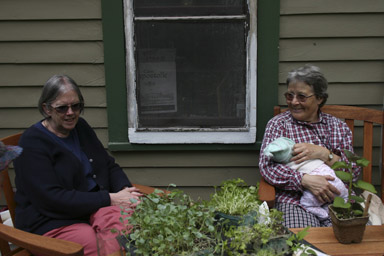
Sungiva with her grandmothers.
For more fun photos, see the second month gallery.
May 30, 2008
Tompkins County Dems state committee endorsements, more
The Tompkins County Democratic Committee met last night for endorsements. Committee members unanimously endorsed Congressmen Mike Arcuri and Maurice Hinchey for re-election.
The rest of the meeting was much more complicated. In particular, the committee also had endorsements for the State Committee. This was why I'd asked about the State Committee on The Albany Project earlier, and I can't say the discussion last night gave me any additional sense that the State Committee does, well, much.
Both incumbents had challengers who were looking for more openness and more change from the State Committee. Challenger Ann Sullivan even did that simple thing that happens too rarely in New York State politics - she looked beyond the state boundaries to see what other state committees were doing. She found a much more active web presence in New Hampshire and Pennsylvania, for instance, and not a whole lot going on at the New York Dems site. I mean, heck, can you imagine seeing this on the New York Committee's site?
The June meeting of the Pennsylvania Democratic Committee is one month away -- have you signed up yet? Come on Friday, June 6, for the trainings and workshops, and make sure buy tickets to the dinner Friday night -- you're never going to believe who the keynote speakers is...more on that later. To find out about trainings and scheduling, just read more
Wow - active outreach? Remarkable!
Probably the most shocking thing, though, was that both Ann and incumbent Peter Stein described the state party's process in similarly bleak terms. Peter did make clear that things had improved somewhat since he arrived twenty years ago, but he certainly described today's party as opaque.
It's not unusual for Tompkins County to be a little out of the mainstream in New York State politics - we were the only county to vote for Obama - but last night made it painfully clear that our incumbents are already pushing the boundaries of what the State Committee can deal with. Lori Gardner is the chair of the Reform Caucus, and Peter has been pushing for process changes pretty much since his arrival.
In the end, the committee endorsed Peter pretty handily, and Lori by a much closer margin. Voting was by secret ballot, with proxies voted. The committee learned a lot more, not much of it enticing, about the State Committee, and it raised a lot of new questions for me about what kinds of reform might be possible in New York State Democratic politics.
There's one other important thing I'd like to note about this. Without Ann Sullivan and Robert Chapman actually mounting a challenge, we wouldn't have had these conversations. We have state committee reports occasionally, but this was apparently the first time in a much longer time than I've been there that the county committee really dug into what this means.
The county committee also endorsed Assemblywoman Barbara Lifton for re-election. I wish I'd recorded former Assemblyman Marty Luster's endorsement speech for some heavy-duty fact-checking on his telling of the garbage truck trainwreck story, but the vote was almost unanimous, except for the same person who'd voted against her last time: me.
This time I actually spoke about it, and perhaps I won't be alone next time. I did get some good questions afterward. What I said was:
I recognize that opposing the endorsement of a candidate when there is no one else running is an unpopular thing to do, by its very nature.
I think, however, that there are times when it is necessary.
This district is not a district where business as usual is a popular campaign theme.
This district needs a representative who sees it as their job to bring our perspectives to Albany, rather than represent Albany to us, as is convenient to the Assembly's leadership.
This district needs a representative who recognizes not only that voting machine choices can disenfranchise users, but that the creative manipulation of legislative district lines can do far more damage.
This district needs a representative who recognizes that the relative silence of voters on state issues reflects grudging acknowledgment of a badly rigged system, not cheerful pleasure in the status quo.
We need more challenges to incumbent state legislators across this state, in both parties.
By voting against endorsing Barbara Lifton, I hope to make it clear that there is support in Tompkins County for those kinds of necessary and invigorating challenges within our Democratic Party. I encourage you to join me, now or in the future.
We'll see where this conversation leads to in that future - I clearly didn't win a lot of votes last night.
We also heard from the Issues Committee, which is revising the platform, and from our Subcommittee on Diversity and Inclusion, which has been working with Town and Ward committees to develop plans for broadening the committee's membership.
[Cross-posted at The Albany Project.]

